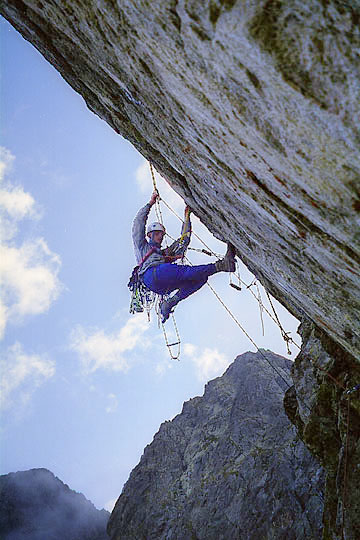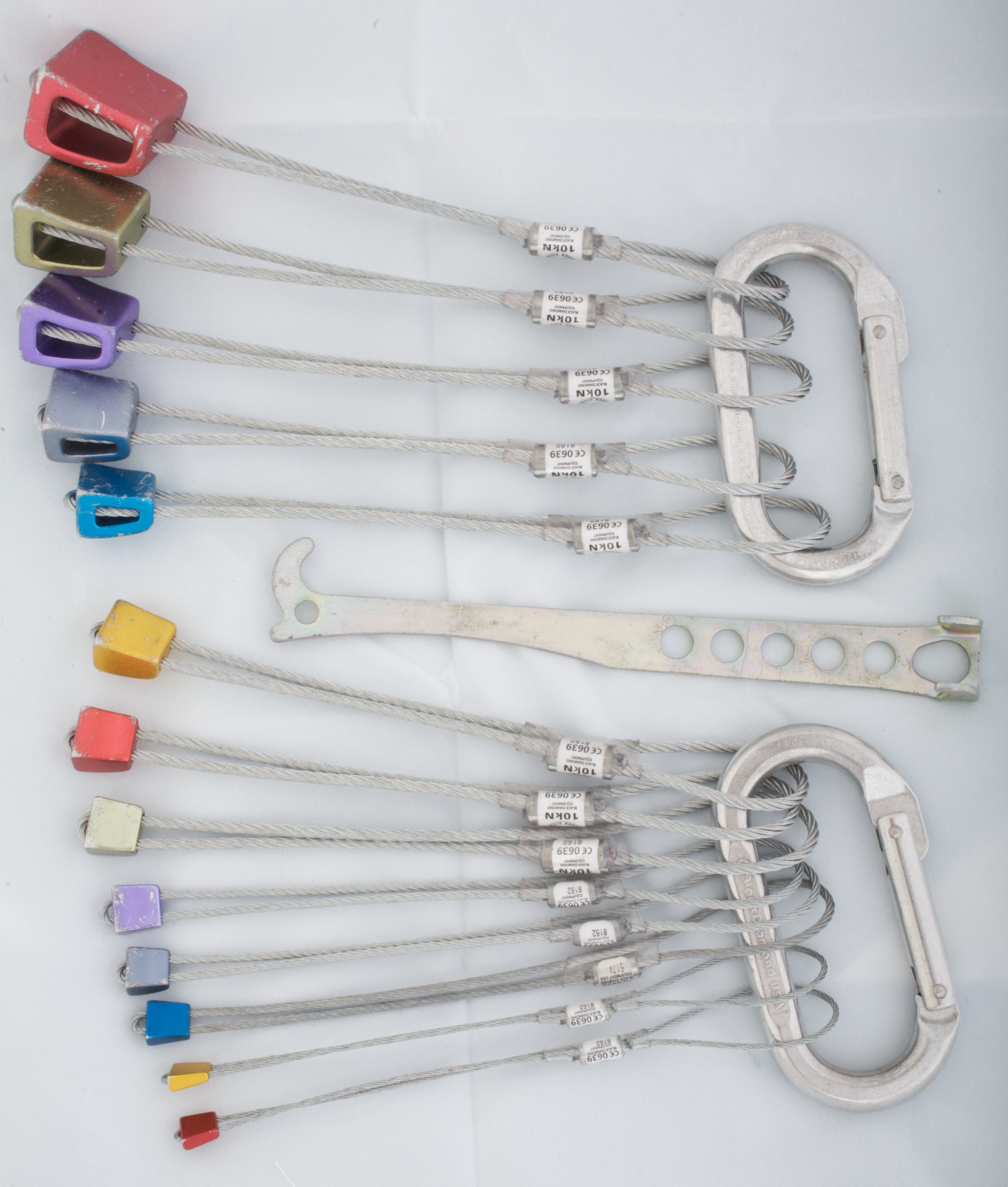|
Piton
A piton (; also called ''pin'' or ''peg'') in big wall climbing and in aid climbing is a metal spike (usually steel) that is driven into a crack or seam in the climbing surface using a Rock climbing hammer, climbing hammer, and which acts as an anchor for protection (climbing), protecting the climber from falling or to assist progress in aid climbing. Pitons are equipped with an eye hole or a ring to which a carabiner is attached; the carabiner can then be directly or indirectly connected to a climbing rope. Pitons were the original form of protection (climbing), protection and are still used where there is no alternative. Repeated hammering and extraction of pitons damage the rock, and climbers who subscribe to the clean climbing ethic avoid their use as much as possible. With the popularization of clean climbing in the 1970s, pitons were largely replaced by faster and easier-to-use clean protection, such as nut (climbing), nuts and spring-loaded camming device, camming devi ... [...More Info...] [...Related Items...] OR: [Wikipedia] [Google] [Baidu] |
Aid Climbing
Aid climbing is a form of rock climbing that uses mechanical devices and equipment, such as aiders (or ladders), for upward momentum. Aid climbing is contrasted with free climbing (in both its traditional or sport free climbing formats), which only uses mechanical equipment for protection, but not to assist in upward momentum. Aid climbing can involve hammering in permanent pitons and bolts, into which the aiders are clipped, but there is also 'clean aid climbing' which avoids any hammering, and only uses removable placements. While aid climbing traces its origins to the start of all climbing when ladders and pitons were common, its use in single-pitch climbing waned in the early 20th century with the rise of free climbing. At the same time, the Dolomites became the birthplace of modern " big wall aid climbing", where pioneers like Emilio Comici developed the early tools and techniques. Aid climbing's "golden age" was in the 1960s and 1970s on Yosemite's granite big ... [...More Info...] [...Related Items...] OR: [Wikipedia] [Google] [Baidu] |
Clean Climbing
Clean climbing is rock climbing techniques and equipment which climbers use in order to avoid damage to the rock. These techniques date at least in part from the 1920s and earlier in England, but the term itself may have emerged in about 1970 during the widespread and rapid adoption in the United States and Canada of nuts (also called chocks), and the very similar but often larger hexes, in preference to pitons, which damage rock and are more difficult and time-consuming to install. Pitons were thus eliminated in North America as a primary means of climbing protection in a period of less than three years. Due to major improvements in equipment and technique, the term ''clean climbing'' has come to occupy a far less central, and somewhat different, position in discussions of climbing technology, compared with that of the brief and formative period when it emerged four decades ago. Rock preservation Drilled and hammered equipment such as bolts, pitons, copperheads and others sca ... [...More Info...] [...Related Items...] OR: [Wikipedia] [Google] [Baidu] |
Yvon Chouinard
Yvon Chouinard (born November 9, 1938) is an American rock climber, environmentalist, and businessman. His company, Patagonia, sells outdoor products, outerwear, and food. He was named one of the 100 most influential people in the world by ''Time'' magazine in 2023. Early life Chouinard's father was a French Canadian handyman, mechanic, and plumber. In 1947, Yvon and his family moved from Lewiston, Maine to Southern California. They were Catholic The Catholic Church (), also known as the Roman Catholic Church, is the List of Christian denominations by number of members, largest Christian church, with 1.27 to 1.41 billion baptized Catholics Catholic Church by country, worldwid .... His early climbing partners included Royal Robbins and Tom Frost.Yvon Chouinard, , Outside Online [...More Info...] [...Related Items...] OR: [Wikipedia] [Google] [Baidu] |
Rock Climbing Hammer
{{Climbing-stub ...
Rock climbing hammers, also known as wall hammers, big wall hammers, yosemite hammers, or aid hammers, are a type of specialty hammer used mainly in aid climbing for the placement and removal of pitons, copper-heads, and circle-heads. They can also be used in the initial placement of fixed anchors ( bolts) or the forceful removal of stuck free climbing protection. File:Climbing Hammer.png, Chouinard Climbing Hammer File:Climbing hammer.png, Climbing hammer See also * Bolt * Climbing equipment * Piton References Hammer A hammer is a tool, most often a hand tool, consisting of a weighted "head" fixed to a long handle that is swung to deliver an impact to a small area of an object. This can be, for example, to drive nail (fastener), nails into wood, to sh ... [...More Info...] [...Related Items...] OR: [Wikipedia] [Google] [Baidu] |
John Salathé
John Salathé (June 14, 1899 – 31 August 1992) was a Swiss-born American pioneering rock climber (and particularly in big wall climbing and in aid climbing), blacksmith, and the inventor of the modern steel piton. In his later years he promoted Christian spiritualism and vegetarianism. Biography John Salathé, also known as Jean Salathé, was born on June 14, 1899, in Switzerland in the village of Niederschöntal, near Basel. He was one of six children. In his hometown, he was an apprentice blacksmith before moving to Paris first, and then Le Havre where he enrolled as a merchant seaman for 4 years, traveling as far as Africa and Brazil. In 1925, Salathé left Bordeaux, in France and travelled to Halifax, Nova Scotia, Canada before travelling to Montreal where he met his wife, Ida Schenk. In March 1930, at the age of 30, Salathé, together with his wife and child, emigrated from Montreal, Canada to finally settle in San Mateo, United States. In 1932, he founded Peninsula Wr ... [...More Info...] [...Related Items...] OR: [Wikipedia] [Google] [Baidu] |
Protection (climbing)
Rock-climbing equipment varies with the specific type of climbing that is undertaken. Bouldering needs the least equipment outside of climbing shoes, climbing chalk and optional crash pads. Sport climbing adds ropes, harnesses, belay devices, and quickdraws to clip into pre-drilled bolts. Traditional climbing adds the need to carry a "rack" of temporary passive and active protection devices. Multi-pitch climbing, and the related big wall climbing, adds devices to assist in ascending and descending fixed ropes. Finally, aid climbing uses unique equipment to give mechanical assistance to the climber in their upward movement (e.g. aiders). Advances in equipment are a key part of the rock climbing history, starting with the climbing rope. Modern devices enable climbers to perform tasks previously done manually, with greater control – in all conditions – and with less effort. Examples of replacements include the harness (replaced tying the rope around the waist) ... [...More Info...] [...Related Items...] OR: [Wikipedia] [Google] [Baidu] |
Big Wall Climbing
Big wall climbing is a form of rock climbing that takes place on long and sheer multi-pitch climbing, multi-pitch climbing routes, routes (of ''at least'' 6–10 pitches or 300–500 metres) that require a full day, if not several days, to ascend. Big wall routes are sustained and exposed and the climbers remain suspended from the continuously sheer and vertical rock face, even sleeping hanging from the face, with limited options to sit down or escape unless they abseil down the route—a complex and risky action. It is therefore a physically and mentally demanding form of climbing. Big wall climbing is typically done in pairs in a traditional climbing format, but with the distinction that the non-lead climber usually ascends by jumaring up a fixed rope to save time and energy. It requires an extensive range of supplies and equipment over and above that of traditional climbing that is carried in haul bags, including portaledges, aid climbing equipment, poop tubes, and food and ... [...More Info...] [...Related Items...] OR: [Wikipedia] [Google] [Baidu] |
Free Climbing
Free climbing is a form of rock climbing in which the climber can only use climbing equipment for climbing protection but not as an artificial aid to help them in ascending the route. Free climbing, therefore, cannot use any of the tools that are used in aid climbing to help overcome the obstacles encountered while ascending a route. The development of free climbing was a transformational moment in the history of rock climbing, including the concept and definition of what determined a first free ascent (or FFA) of a route by a climber. Free climbing can be performed in several rock-climbing formats that vary with the type of climbing protection that is used. Thus, free climbing can be done as traditional climbing (which only uses temporary removable climbing protection), sport climbing (which only uses permanently fixed in-situ climbing protection), and bouldering and free solo climbing (both use no climbing protection whatsoever). Free climbing is sometimes misunderstood as ... [...More Info...] [...Related Items...] OR: [Wikipedia] [Google] [Baidu] |
Tom Frost
Thomas "Tom" M. Frost (June 30, 1936 – August 24, 2018) was an American rock climbing, rock climber known for big wall climbing first ascents in Yosemite Valley. He was also a photographer and Rock-climbing equipment, climbing equipment manufacturer. Frost was born in Hollywood, California, and died in Oakdale, California. Rock climbing and mountaineering Frost grew up in Newport, California and was a sailing champion as a teenager, winning the United States Snipe National Championship, Snipe National Championship in 1953 and 1954. In 1958, he graduated with a degree in mechanical engineering from Stanford University, where he was a member of the Stanford Alpine Club. Frost began making first ascents in Yosemite in 1958. In 1960, he made the second ascent of The Nose (El Capitan), The Nose on El Capitan in Yosemite Valley, a route pioneered by Warren Harding (climber), Warren Harding in 1958. He climbed with Royal Robbins, Chuck Pratt and Joe Fitschen. In 1961, Frost and ... [...More Info...] [...Related Items...] OR: [Wikipedia] [Google] [Baidu] |
Nut (climbing)
In rock climbing, a nut (or ''chock'' or ''chockstone'' or wire for the smallest versions) is a metal wedge threaded on a wire that climbers use for protection by wedging it into a crack in the rock. Quickdraws are clipped to the nut wire by the ascending climber and the rope threads through the quickdraw. Nuts come in a variety of sizes and styles, and several different brands are made by competing manufacturers. Most nuts are made of aluminum. Larger nuts may be threaded on Dyneema cord instead of wire, but this has become unusual. The very smallest nuts are known as ''micronuts'' and may be made of brass or other metal, and typically have their wires soldered into them, instead of looped through drilled holes. They are mostly used in aid climbing, and their value as protection, arresting a climber's fall, is marginal because of both their low breaking strength and their tiny surface area (the HB 0 measures about 4 x 7 x 2.5 mm) in contact with the rock, though this can be o ... [...More Info...] [...Related Items...] OR: [Wikipedia] [Google] [Baidu] |





